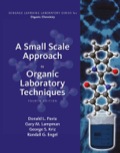
Interpretation:
The reason for 2-bromobutane to react faster than 2-chlorobutane in the test ofsilver nitrate with ethanol and
Concept Introduction:
Answer to Problem 1Q
In 2-bromobutane, -Br is a better leaving group than −Cl therefore it reacts faster than 2-chlorobutane.
Explanation of Solution
Given information:
Both 2-bromobutane and 2-chlorobutane give positive test with silver nitrate with ethanol and KI with acetone.
In 2-bromobutane, -Br is a better leaving group than −Cl therefore it reacts faster than 2-chlorobutane. The −Br leaving group is a weak base therefore it is a good leaving group compare to −Cl which is a stronger base and weak leaving group.
Hence 2-bromobutane reacts faster than 2-chlorobutane with silver nitrate with ethanol and
In 2-bromobutane, -Br is a better leaving group than −Cl therefore it reacts faster than 2-chlorobutane.
Want to see more full solutions like this?
Chapter 19 Solutions
EBK A SMALL SCALE APPROACH TO ORGANIC L
- What is a protecting group in a multi synthesis reaction in organic chemistry?arrow_forwardA compound of molecular formula C5H10O forms a yellow precipitate with 2,4-dinitrophenylhydrazine reagent and a yellow precipitate with reagents for the iodoform test. a) Draw the structural formulae b) Name the two (2) compounds that fit these tests.arrow_forward4 Why must the mixture of (Ethanol, Ethanoic acid and sulphuric acid) not be boiled during esterification process? 5- Write down the type of 2-methyl-2-propanol?arrow_forward
- Identify the substitution products that form when 2-bromo-2-methylpropane is dissolved in a mixture of 80% ethanol and 20% water. a. Explain why the same products are obtained when 2-chloro-2-methylpropane is dissolved in a mixture of 80% ethanol and 20% water.arrow_forwardPossible alternative brominations include: Veratrole (1,2-dimethoxybenzene) to 1,2-dibromo-4,5-dimethoxybenzene; 4-Methylacetanilide to 2-bromo-4-methylacetanilide; 2-Methylacetanilide (made in experiment S.1) to 4-bromo-2-methylacetanilide; Vanillin to 5-bromovanillin; Acetanilide to 4-bromoacetanilide; a. b. C. d. e. EXPERIMENT S4: BROMINATION OF AROMATIC COMPOUNDS Certain other acetanilides made in experiment S.1 may also be used as precursors in this experiment. Estimated time: 1 afternoon Associated learning goals: Section 6, LG 6.6; Section 7, LG 7.2 and 7.4 Pre-lab report: complete the standard report form, and answer the following questions. In this experiment, molecular bromine (Br2) is generated from the redox reaction of potassium bromate with hydrobromic acid. Write a balanced equation for this process. Briefly outline the mechanism by which Br2 brominates your aromatic compound. Why do the bromine atoms end up at the positions indicated rather than anywhere else in the…arrow_forwardExplain why acetyl chloride reacts faster with water than acetic anhydride does?arrow_forward
- what is the best way to come up with how to synthesize carboxylic acid , oct-4-yne to butanoic acid, or trans cyclodecene to decanedoic acid . I keep getting confused on how to go from the reactants to product, even with the amines. i can't figure out what to use to get to the product. Please explain Grignard rx as well.arrow_forwardWhy is terbutyl chloride the organic phase and hydrochloric acid is the aqueous phase in the aliphatic nucleophilic substitution reaction between Terbutanol and HCl?arrow_forwardaldehydes and ketones Which of the tests (one or more) would you use for acetone, n-butanal, 2-furaldehyde (furfural), 2-heptanone, 3-heptanone, n-heptanal, 2-octanone, propionphenone? ex. You use tollen's test to determine the unknown as benzaldehyde. Tests available: 2,4-dinitrohpenylhydrazones test (add 2,4 dinitrophenylhydrazine in phosphoric acid) semicarbazones test tollen's test shiff's test idoform test bisulfite testarrow_forward
- Describe the product formed as a result of the reaction between cyclohexanone and 3-butene-2-one by also writing the mechanism of the reaction.arrow_forwardWhat three alkenes (excluding stereoisomers) can be used to prepare 3chloro-3-methylhexane by addition of HCl?arrow_forwardWhat is the role of triethylamine in this reaction? Draw the curly arrow reaction mechanism to show bonds being broken/formed.arrow_forward
 ChemistryChemistryISBN:9781305957404Author:Steven S. Zumdahl, Susan A. Zumdahl, Donald J. DeCostePublisher:Cengage Learning
ChemistryChemistryISBN:9781305957404Author:Steven S. Zumdahl, Susan A. Zumdahl, Donald J. DeCostePublisher:Cengage Learning ChemistryChemistryISBN:9781259911156Author:Raymond Chang Dr., Jason Overby ProfessorPublisher:McGraw-Hill Education
ChemistryChemistryISBN:9781259911156Author:Raymond Chang Dr., Jason Overby ProfessorPublisher:McGraw-Hill Education Principles of Instrumental AnalysisChemistryISBN:9781305577213Author:Douglas A. Skoog, F. James Holler, Stanley R. CrouchPublisher:Cengage Learning
Principles of Instrumental AnalysisChemistryISBN:9781305577213Author:Douglas A. Skoog, F. James Holler, Stanley R. CrouchPublisher:Cengage Learning Organic ChemistryChemistryISBN:9780078021558Author:Janice Gorzynski Smith Dr.Publisher:McGraw-Hill Education
Organic ChemistryChemistryISBN:9780078021558Author:Janice Gorzynski Smith Dr.Publisher:McGraw-Hill Education Chemistry: Principles and ReactionsChemistryISBN:9781305079373Author:William L. Masterton, Cecile N. HurleyPublisher:Cengage Learning
Chemistry: Principles and ReactionsChemistryISBN:9781305079373Author:William L. Masterton, Cecile N. HurleyPublisher:Cengage Learning Elementary Principles of Chemical Processes, Bind...ChemistryISBN:9781118431221Author:Richard M. Felder, Ronald W. Rousseau, Lisa G. BullardPublisher:WILEY
Elementary Principles of Chemical Processes, Bind...ChemistryISBN:9781118431221Author:Richard M. Felder, Ronald W. Rousseau, Lisa G. BullardPublisher:WILEY





